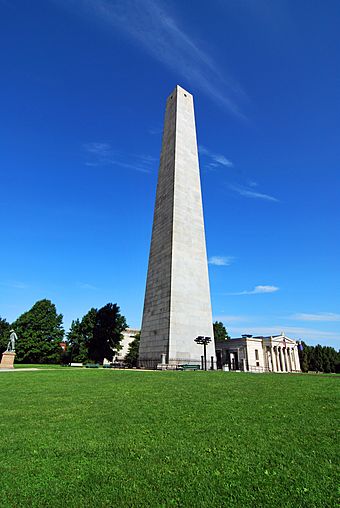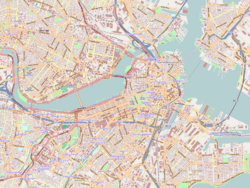Bunker Hill Monument facts for kids
|
Bunker Hill Monument
|
|
|
U.S. Historic district
Contributing property |
|

Pictured in 2019
|
|
| Location | Boston, Massachusetts |
|---|---|
| Built | 1825–43 |
| Architect | Willard, Solomon |
| Architectural style | Obelisk |
| Part of | Monument Square Historic District (ID87001128) |
| NRHP reference No. | 66000138 |
Quick facts for kids Significant dates |
|
| Added to NRHP | October 15, 1966 |
| Designated NHL | January 20, 1961 |
| Designated CP | June 2, 1987 |
The Bunker Hill Monument stands tall in Boston, Massachusetts. It marks the spot of one of the first big battles in the American Revolutionary War. This war was fought between the United Colonies (who later became the USA) and the British Empire.
The monument is a huge granite obelisk, which is a tall, four-sided pillar that tapers to a pyramid shape at the top. It is 221 feet (67 meters) high. Workers built it between 1825 and 1843 in Charlestown, Massachusetts. The granite came from Quincy and was moved using a special Granite Railway and then by boat. You can climb 294 steps to reach the very top!
Near the monument's base, there's a lodge from the late 1800s. Inside, you'll find a statue of Joseph Warren, an important figure from the battle. The Bunker Hill Monument is a key stop on the famous Freedom Trail. It is also part of the Boston National Historical Park.
The monument got a big makeover that finished in 2010. This $3.7 million project fixed things up, made it easier for people with disabilities to visit, and added new lights. The Bunker Hill Museum is across Monument Square. It opened in June 2010 and has many cool exhibits about the battle.
Contents
Why is it called Bunker Hill?
This monument was one of the first big memorials in the United States. It's interesting because it's not actually on Bunker Hill! Most of the fighting in the Battle of Bunker Hill happened on a nearby place called Breed's Hill. So, the battle's name is a bit misleading.
An earlier memorial was put up in 1794. It was an 18-foot (5.5-meter) wooden column with a golden urn on top. This was to remember Joseph Warren, who was a Mason.
A group called the Monument Association bought the entire battlefield by 1825. But to pay for the monument's completion, they had to sell most of the land in 1838. They kept only the very top of the hill for the monument.
In front of the tall obelisk today, there is a statue of Colonel William Prescott. He was from Groton, Massachusetts. Many stories say he told his soldiers, "Don't fire until you see the whites of their eyes!" during the battle. While this phrase is famous, historians believe it was actually much older and used by other commanders before this battle.
Exploring Breed's Hill
Breed's Hill is a small, rounded hill in the Charlestown area of Boston. It's located on the southern part of the Charlestown Peninsula. This peninsula was once connected to the mainland by a narrow strip of land.
Breed's Hill is famous because most of the fighting in the Battle of Bunker Hill happened here in 1775. This was early in the American Revolutionary War. Over time, the shape of the peninsula changed a lot. People filled in parts of the Charles River between Cambridge and Charlestown.
Today, many homes are built on Breed's Hill. But the top part is where you'll find the Bunker Hill Monument. There are also other memorials that remember the battle.
The hill is about 62 feet (19 meters) high. Monument Square, where the Bunker Hill Monument stands, is at its peak. The hill slopes down quite steeply on its east and west sides. Besides its historical sites, the hill has many houses, shops, and city buildings. It's about 700 yards (640 meters) from Bunker Hill itself.
The Battle's Story
The American soldiers heard that the British planned to build forts on the Charlestown peninsula. So, the Americans decided to get there first! Their plan was to build their own defenses and make the British leave Boston.
On June 16, 1775, under the command of General Putnam and Colonel Prescott, the Americans secretly moved onto the Charlestown Peninsula. They were told to set up defenses on the hills overlooking Boston.
They built a "redoubt," which is a small, temporary fort, on Breed's Hill. They chose Breed's Hill because it was closer to Boston than Bunker Hill. The next morning, June 17, the British were shocked to see the American forts on the hill. They quickly prepared to attack and take back the peninsula. The fight became known as the Battle of Bunker Hill. This was because Prescott had originally planned to build the forts on Bunker Hill. Also, some people thought Breed's Hill was just part of Bunker Hill.
British soldiers, led by General Howe, sent 2,400 men to attack Breed's Hill. About 1,500 American colonists fought back and stopped two British attacks. But during the third attack, by British Royal Marines, the Americans had to retreat. About 450 colonists were killed or wounded. The British had even more casualties, with about 1,150 killed or wounded.
In 1825, the Bunker Hill Monument Association started building the monument. They bought 15 acres (6.1 hectares) of land for this important project.
Building the Monument
William Ticknor, a lawyer from Boston, first suggested building a memorial. A group of important men met to discuss the idea. On May 10, 1823, the first public meeting was held. Each person gave five dollars. Then, on June 7, 1823, the Bunker Hill Monument Association officially began. They started raising money for the monument. Famous helpers like Amos Lawrence and Judah Touro each promised $10,000 to help get the monument built.
In the spring of 1825, the directors had bought about 15 acres (6.1 hectares) on Breed's Hill. But they still needed to pick a design. They offered $100 for the best design, and about 50 plans were submitted. They narrowed it down to a column or an obelisk. Finally, they chose the obelisk design by Solomon Willard.
The directors laid the first stone, called the cornerstone, on June 17, 1825. The Marquis de Lafayette, a French hero of the American Revolution, performed the ceremony. Daniel Webster gave a powerful speech. Many important people attended, including 190 veterans who had fought in the battle. More than 100,000 people came to watch this special event.
The huge granite blocks for the monument were quarried by splitting them with wedges. Each block was about 2 cubic yards (1.5 cubic meters). They were brought to the site for a low cost of $5.40 per cubic yard. Moving these heavy blocks was slow at first. But then the Granite Railway was finished quickly. It started running on October 7, 1826. This was the first commercial railroad in the United States that carried goods for everyone.
Building the monument often stopped because they ran out of money. To finish the project, the Monument Association started selling parts of the battlefield as house lots in 1838. They successfully raised the money they needed. They sold about two-thirds of the land, keeping only the top of Breed's Hill for the monument. Some neighbors were unhappy with the unfinished monument. It's said they even thought about raising money to tear it down! However, Sarah Josepha Hale and the readers of her magazine helped raise the money needed to finish it.
The very top stone, called the capstone, was placed on July 23, 1842. The monument was officially dedicated on June 17 of the next year. Again, Daniel Webster gave a speech. Students from the Boston Latin School even helped build this famous Boston landmark.
The Bunker Hill Monument Association took care of the monument until 1919. Then, it was given to the state of Massachusetts. In 1976, the monument became part of the National Park Service. It is now a unit of Boston National Historical Park. The monument was named a National Historic Landmark in 1961. This was because it was an important early war memorial and the largest memorial in the country before the Washington Monument was built. It was added to the National Register of Historic Places in 1966. Later, in 1987, it became part of the Monument Square Historic District.
Image gallery
See also
 In Spanish: Monumento de Bunker Hill para niños
In Spanish: Monumento de Bunker Hill para niños











